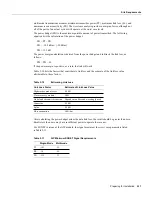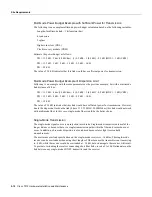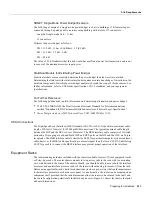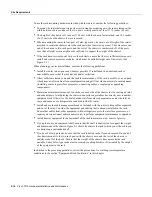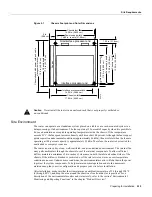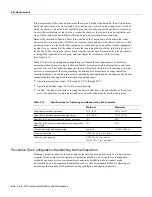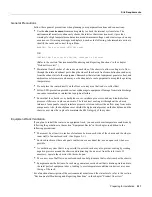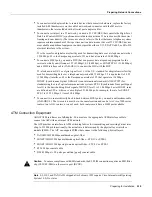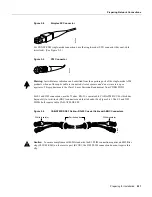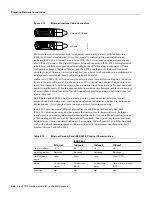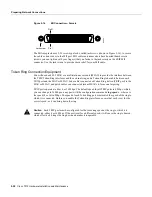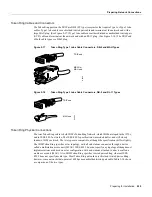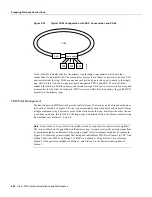
2-24 Cisco 7010 Hardware Installation and Maintenance
Preparing Network Connections
Figure 2-12
Ethernet Interface Cable Connectors
The term Ethernet is commonly used for all carrier sense multiple access/collision detection
(CSMA/CD) local-area networks (LANs) that generally conform to Ethernet specifications,
including IEEE 802.3. Ethernet Version 2 and IEEE 802.3 were based on, and developed shortly
after, Ethernet Version 1. The slight differences between Ethernet and IEEE 802.3 are implemented
in hardware, and both are supported automatically by the EIP without any hardware or software
configuration changes. Together, Ethernet and IEEE 802.3 are the most widely used local-area
network protocol. They are well suited to applications where a local communication medium must
carry sporadic, occasionally heavy traffic at high peak data rates.
Stations on a CSMA/CD LAN can access the network at any time. Before sending data, the station
listens to the network to see of it is already in use. If it is, the station waits until the network is not
in use, then transmits. A collision occurs when two stations listen for network traffic, hear none, and
transmit simultaneously. When this happens, both transmissions are damaged, and the stations must
retransmit them. The stations detect the collision and use backoff algorithms to determine when they
should retransmit.
Both Ethernet and IEEE 802.3 are broadcast networks, which means that all stations see all
transmissions. Each station must examine received frames to determine whether it is the intended
destination and, if it is, pass the frame to a higher protocol layer for processing.
IEEE 802.3 specifies several different physical layers, and Ethernet defines only one. Each
IEEE 802.3 physical layer protocol has a name that summarizes it characteristics in the format
speed/signalling method/segment length where speed is the LAN speed in Mbps, signaling method
is the signaling method used (either Baseband or Broadband), and segment length is the maximum
length between stations in hundreds of meters. For example, 10Base5 specifies a 10-Mbps Baseband
LAN with network segments spaced at 500 meters.Table 2-13 summarizes the characteristics of
Ethernet Version 2 and IEEE 802.3.
Table 2-13
Ethernet Version 2 and IEEE 802.3 Physical Characteristics
Ethernet
IEEE 802.3
10Base5
10Base2
10BaseT
Data rate (Mbps)
10
10
10
10
Signaling method
Baseband
Baseband
Baseband
Baseband
Max. segment
length
500m
500m
185m
100m (UTP)
Media
50-ohm coax
(thick)
50-ohm coax
(thick)
50-ohm coax
(thin)
Unshielded twisted pair
(UTP)
Topology
Bus
Bus
Bus
Star
H1347a
Network/XCVR end
EIP end
Содержание TelePresence Server 7010
Страница 10: ...x Cisco 7010 Hardware Installation and Maintenence ...
Страница 14: ...iv Cisco 7010 Hardware Installation and Maintenance Document Conventions ...
Страница 112: ...2 52 Cisco 7010 Hardware Installation and Maintenance Initial Configuration Information Page ________ ...
Страница 148: ...3 36 Cisco 7010 Hardware Installation and Maintenance Using the Flash Memory Card ...
Страница 158: ...4 10 Cisco 7010 Hardware Installation and Maintenance Troubleshooting the Processor Subsystem ...
Страница 242: ...5 84 Cisco 7010 Hardware Installation and Maintenance Replacing Internal Components ...
Страница 258: ...A 16 Cisco 7010 Hardware Installation and Maintenance MIP Interface Cable Pinouts ...
Страница 270: ...B 12 Cisco 7010 Hardware Installation and Maintenance Interface Processor LEDs ...
Страница 274: ...C 4 Cisco 7000 Hardware Installation and Maintenance ...
Страница 287: ...Index 13 ...


